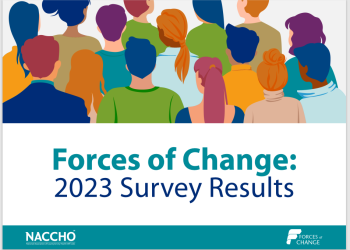By Sarah Summers, MPH, NACCHO Senior Program Analyst
In commemoration of National Preparedness Month, the Centers for Disease Control and Prevention (CDC) is highlighting five themes for each week of September, emphasizing the various aspects of effective preparedness. Each week, the NACCHO Preparedness team is authoring a blog to promote the theme and provide local health departments and other partner agencies with context and resources to share with the communities they serve. This week’s theme is “Prepare to Respond.”
***
Over the past 10 years the U.S. has faced a myriad of public health emergencies, measles in California, Hurricane Sandy, foodborne illness outbreaks, and pandemic influenza in 2001, just to name a few. The CDC’s emergency operations centers (EOC) has been activated 62 times since 2001. This national-level EOC monitors, coordinates and assists state and local level operations centers in responding to public health emergencies across the country. So how does our nation prepare for these responses?
Utilizing national preparedness standards, state and local public health agencies have established public health preparedness programs to plan, train and exercise for response to public health emergencies. State and local public health agencies use a variety of tools and standards to continuously assess and improve their capacity and capability to respond to emergencies. Just a few examples of these tools and standards, include:
- The Homeland Security Exercise and Evaluation Program is a standard framework for conducting emergency preparedness drills and exercises.
- The Hospital Preparedness Capabilities are a set of standards developed by the Assistant Secretary for Preparedness and Response to assist our healthcare system in assessing and improving public health preparedness capacity and capability.
- The Public Health Preparedness Capabilities are planning standards for state and local public health agencies developed by Centers for Disease Control and Prevention.
But how does a local health department (LHD) know if they are prepared to respond? Planning, training, and facilitating regular staff and community exercises are three essential components local health officials must incorperate to implement a comprehensive public health response. Planning for public health emergencies requires LHDs to maintain a written all-hazards emergency operations plan. This plan lays out standard operating procedures and outlines the agency’s strategy for responding, mitigating, and recovering from public health emergencies. A prepared LHD is directly associated with having a prepared workforce. LHD leadership must equip their staff with the knowledge, skills, and confidence to respond and recover from emergencies. Two highly effective measures to ensure this aim include developing a training needs assessment and a workforce development plan that incorporates the 15 CDC Public Health Preparedness Capabilities. There is no such thing as a perfect disaster response but they say practice makes perfect for a reason. Utilizing HSEEP allows LHD staff, partner agencies, and community members to share a common language, planning, and evaluation templates for exercises and drills. Furthermore, practicing for public health emergencies helps individuals and organizations develop confidence in their ability to execute operational plans as well as identify areas for continued development in their collective capacity and capability.
These three essential elements of planning, training and exercising, also happen to be the cornerstones of Project Public Health Ready (PPHR). PPHR is a competency based training and recognition program for LHD preparedness programs. Since 2003 more than 450 public health agencies from 27 states have been PPHR recognized. PPHR applicants submit documentation for criteria that fall under three goals, including an all-hazards preparedness plan, workforce capacity development, and exercise or real incident response documentation and future planning. These goals and the corresponding criteria elements are continually assessed and aligned with the national preparedness standards noted above. With the support of a state-level entity LHDs are working to develop and submit evidence for each criteria element within these goals.
Agencies receiving PPHR recognition are assessed, by their peers, who determine if the organization has met the highest standards for local public health preparedness and response. Subject matter experts recruited from LHDs across the country review evidence and provide feedback to applicants, identifying best practices and areas for improvement. The goal of PPHR is to foster a system where LHDs are fully integrated into the response community. PPHR provides clear and consistent evaluation of an agency’s response capability and also aligns with key elements of other federal initiatives like National Incident Management System (NIMS), HSEEP and the Operational Readiness Review (ORR). Participating in PPHR helps identify community resources, builds relationships with response partners, demonstrates return on investment in preparedness activities, and fosters a cycle of continuous quality improvement. The tools and best practices collected from PPHR applicants are available in the NACCHO toolbox by entering PPHR toolkit in the search box.
Preparing our nation, states and communities to respond to disaster is a collective responsibility. Using national standards for preparedness such as HSEEP, hospital preparedness capabilities, public health preparedness capabilities, and PPHR fosters a cohesive approach to disaster response and recovery. When federal, state, and local partners plan, train, and evaluate utilizing standard tools and criteria we are all better prepared to respond.
***
Local health officials, MRC Unit volunteers, and other partner stakeholders are highly encouraged to share all of their preparedness efforts, resources, and community engagement events throughout National Preparedness Month. Both LHDs and MRC Units are invited to take the NACCHO Preparedness Pledge, participate in our National Preparedness Month Photo Contest, and submit an abstract for our upcoming 2017 Preparedness Summit.








